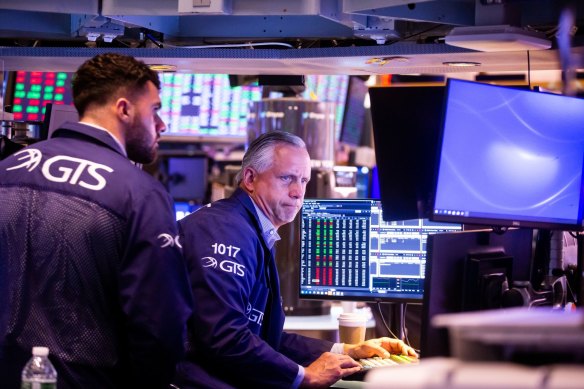ASX set to edge lower as Wall Street slides; $A slumps
By Damian Troise and Alex Veiga
Stocks are lower on Wall Street in afternoon trading on Wednesday, led by drops in big technology companies and erasing the S&P 500’s gains for the week.
The S&P 500 is 0.3 per cent lower in late trade while the Dow Jones has lost 0.2 per cent and the tech-heavy Nasdaq has retreated by 0.7 per cent. Trading has been choppy throughout the week as the benchmark index comes off a four-week winning streak.

The Australian sharemarket is set to edge lower with futures at 4.59am AEST pointing to a dip of 3 points at the open. On Wednesday, the ASX added 0.3 per cent. The Australian dollar has retreated sharply to be 1.2 per cent lower at 69.37 US cents at 5.16am AEST.
Small-company stocks fell more sharply than the rest of the market on Wall Street. The Russell 2000 has fallen by 1.3 per cent.
Pricey technology companies and retailers had some of the biggest losses. Utilities and energy stocks held up better than the broader market.
Wall Street was absorbing a mix of retail updates that showed inflation pressure continues to affect businesses and consumers, but also shows that spending remains strong.
Target fell 2.6 per cent after reporting a nearly 90 per cent plunge in second quarter profits as it was forced to slash prices to clear unwanted inventories. The retailer warned earlier this summer that it was cancelling orders from suppliers and aggressively cutting prices because of a pronounced spending shift by Americans as the pandemic eased.
Children’s clothing and accessories chain Children’s Place fell 9.7 per cent after reporting a surprise second-quarter loss as it faced supply chain problems and pressure from inflation.
Bond yields rose significantly. The yield on the 10-year Treasury rose to 2.89 per cent from 2.81 per cent late Tuesday.
Sales at US retailers were unchanged last month, according to the Commerce Department, and economists had expected a slight increase in July. Part of the weakness came from a 1.8 per cent drop in gas sales, reflecting lower prices at the pump.
Wall Street has been closely reviewing the latest economic data and corporate updates to get a better sense of how inflation is affecting businesses and consumers and whether the hottest inflation in 40 years is peaking or beginning to cool. Investors are also monitoring inflation to determine how much further central banks have to go in their fight against higher prices.
Britain’s inflation rate rose to a new 40-year high of 10.1 per cent in July, a faster pace than in the US and Europe as climbing food prices in the United Kingdom tightened a cost-of-living squeeze fuelled by the soaring cost of energy. Inflation pressures prompted the Bank of England to boost its key interest rate by half a percentage point this month, the biggest of six consecutive increases since December.
The Federal Reserve has been raising interest rates in order to slow the economy and temper inflation, but investors remain concerned that it could hit the brakes too hard and send the economy into a recession. The Fed in July raised its benchmark interest rate by three-quarters of a point for a second-straight time. Wall Street will get more details on the process behind that decision when the Fed releases minutes from that meeting later on Wednesday.
Most Viewed in Business
Source: Thanks smh.com